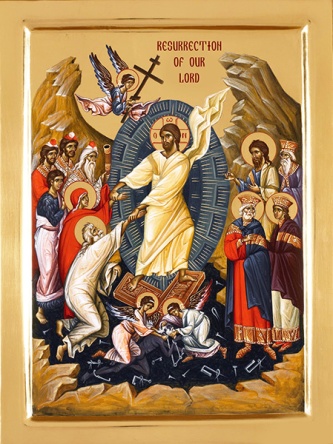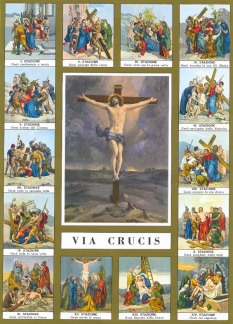
CHRIST IS RISEN, ALLELUIA!
I hope that you have enjoyed the serialized version of my revision of Lent for Busy People. It has been a joy to share it with you, and my hope is that it will be out in paperback well in time for Lent 2019.
For this Easter Sunday, I am reprinting a 1901 sermon by the late Bishop of New York, the Right Reverend Henry Potter.
Blessings of this Feast of the Resurrection to you and yours!
Canon Charles Nalls
“Who shall roll us away the stone from the door of the Sepulchre?” St. Mark xvi:3.
What an unlooked for and triumphant answer did they get who uttered that perplexed demand! They come, three sorrow-stricken women, to anoint their Master for His burial with hope quite dead in their bosoms, yet their love longs to pour itself out even upon their Lord’s insensible remains, and with tenderest ministries to make His dead body ready for the grave. And so, very early in the morning, “at the rising of the sun” they turn their footsteps toward His Sepulchre. Their hands bear aloes and myrrh, and every costliest antiseptic that their deep devotion can command, and in their woman’s weakness, their only thought now is, who shall be strong enough to roll away the stone?
That sealed and close shut Tomb; who would unlock it for their entrance? Their hearts never lift themselves above that poor dilemma. If they ever understood their Master’s promised victory over the grave, events have quenched their confidence in it now. To their eyes, the world’s forces seem to have been too Strong even for the powers that were His. Their hopes have been baffled, their glad anticipations quenched in tears–their Lord is dead, and now as they bend their steps to that new tomb in which His pulseless form was yesterday laid to rest, neither their expectations nor their fears can reach beyond the plaintive question–” Who shall roll us away the stone?”
They come to find that tomb an empty casket–they come to find its door wide open, and its tenant gone. Nay, they come to learn that He who yesterday was sleeping there, has wakened out of his sleep, and waiting for no earthly hands to give Him liberty, has passed the guarded portal, and scorning every poor material impediment, has gone forth alive again and free! An angelic hand has indeed rolled away the stone, and one clad in white raiment bids them see the place where only a little while before, their Master lay. But we must not overlook the fact which the Gospels make so plain, that when the angel comes to roll away the stone, Christ is already gone. He has needed no outward interposition to set Him free. When angels come to lift away the granite door, the rocky tomb is empty, and they are sent only the more unequivocally to show forth that emptiness to others. Within that grave had lain a force which no stone, however huge, could prison, nor any seal, however princely, bind. That life which Christ brought with Him out of heaven was mightier than any grave, and strong enough to brush aside the most huge and massive rock which could be rolled before it.
Is not this, now, the especial emphasis of what we call our Easter-fact? That fact finds fittest utterance in our Easter legend “now is Christ risen.” Our Easter joy is not the outgrowth of a speculation. Our anthem peals are not the purified prettiness of empty sentiment. Today we stand upon a fact, a fact against which unbelief has hurled its hostile waves in vain. The Lord is risen indeed. If that be not a fact; if every soundest rule of evidence does not authenticate it to us as a fact, then there is nothing under heaven susceptible of proof. If anything in all the past is true, then this is true–that out of that tomb into which Christ was day before yesterday borne a corpse, He went forth on that first Easter day a living man. On that fact we rest–take it away, and I own, freely, that the superincumbent structure crumbles to nothingness. On this ground the Apostle plants himself without equivocation. “If Christ be not risen, then is our preaching vain, and your faith is also vain.” “But now is Christ risen from the dead.” That fact is our sheet anchor! But in what, I ask, resides its chiefest emphasis? What is it that Christ’s rising certifies to us? How is it that His victory intimates a victory for us? What is the law of which it is the high and bright disclosure?
It is because, by force of contrast, they throw out into such strong relief the heart-broken question of these tearful women for my text. For that question leads directly to radiant truth on which our Easter joy must rest. They thought Christ cold and stark and impotent. To approach Him and release His lifeless body, some power external to that body in its utter helplessness must be invoked to roll away the stone. But what a complete and radical mistake theirs was! Was Christ a prisoner there dependent on the chance ministries of some external hands to set Him free?
Ah, no! He waited for no angel, for, into that grave, when He descended to it, He carried a seed of life which of itself was strong enough to burst the seal and roll away the stone and give Him triumphant freedom!
The law of our life in Him is simply that His life passes over into us to be a quickening within us stronger than any grave. Does death steal suddenly on our households, taking away the forms our love has clung to? No matter! The life that has apprehended Him has in it that which is stronger than any grave. Or, do we feel in ourselves the growing sense of physical infirmities, and are we forced to own that the frail shrine through which our soul looks out on life is tottering to its fall? Still, what does it matter? Is it not true of every life that has fixed its grasp on Christ that just as with a beautiful and prophetic imagery the ancients buried their dead with seeds clasped in their hands, so our own hands have hold upon a principle of life potent enough to break through every bondage of the grave? We lay our dead to rest with no such dreary emblems as the pagan past discloses. Study the symbolism of the grave before Christ entered the world and see how hopeless it was. The broken column, the torch inverted in the chiseled stone, what did such signs as these proclaim but that in the eyes of those who used them, death had shattered the half-complete career, and left only ruin and darkness behind it?
Nay, we turn back to see the same hopelessness in those, whose rare endowments ought, we think, to have lifted their thought above the common gloom. Alas, they did not. We read the dialogues of Plato, and in them oftener than otherwise, there moans the sad undertone of blank uncertainty, we go to Cicero sitting grief-stricken in his Tuscan villa beside the dead body of his daughter, and as his eager thoughts run onward to her grave, what is his outcry, thinking of the gloom so soon to shut him out from her forever, but the dim echo of that question Who is there that can roll away the stone? Ah, yes, through tear-dimmed centuries the question rang, and waited for an answer! In homes into whose glad serenity the shadow of the death-angel had forced its unsparing way, –from quivering lips left alone beside the graves that hid away out of their sight their loved and lost, wrung out of grief-burdened hearts that could not let their dear ones go, there came that cry, “Who is there brave enough and strong enough to roll away the stone?” And now we have their answer. Not as they looked for it, did it come, but by the clear disclosure of a truth how much more grand and gracious. Our sainted dead are not dependent on the help even of the angels, for they have taken the key that unlocks their prison door into the grave itself. The seeming victory of death is only seeming. Our Leader spoiled it when He died Himself. His burial was only one more step towards a fuller, freer life. And what was true of Him became thenceforward true of that humanity for which He died!
We may go back to nature now, and see how crowded full with these analogies it is. For nature is life. Anything in it that looks like death is but a token and certificate of life about to commence anew. Every end there is only a beginning–some lower form letting go its life and casting away its coarser self that it may re-appear again in forms more beautiful and pure. The mere leaves that seem to fade and rot, pass downward into the root life of some rarer plant more lovely than themselves, and when the sun and rains summon them anew come forth in forms more wonderful and hues rarer than ever they had known before. The creeping worm dies out of its meaner life into a winged form beauty which Egyptian art and Christian symbolism have alike borrowed to utter, the one its struggling hope–the other its clear undoubting faith. And this is at once the fitness and suggestiveness of our Easter blossoms. We miss the lessons of yonder flowers if we look on them as forms of mere adornment, or see in them only the hues and fragrance of a fleeting life. Beautiful as they are, like us, they will fade and fail. But their supreme appropriateness lies in this, that in all plant life under Heaven, death is the stepping stone to life more fair and rich, the law of which is held within themselves. The autumn winds strip the plant’s branches bare, and wither its blossoms and to outward semblance, quench the life of it wholly. But when the spring rains come again and the sun’s kindlier rays kiss the greenness back into the shriveled branches, there has been at work all the time an answering law of life within those branches, more powerful than all other powers besides. And thus, our vernal buds best symbolize our Easter fact.
How can our hearts then refuse to echo those notes of triumphant gladness with which this morning the Church’s services are ringing? How are our griefs transmuted, and our tears turned backward in their channels, as looking down into the empty sepulcher of Christ we find it a grave no longer, but transformed into the most glorious fabric and most solemn temple ever hewn by mortal hands–its open portal the firmest basis of the imperishable hopes of humanity and its ascended occupant the Everlasting pledge of what even death may be made to minister to us.
Read Full Post »

